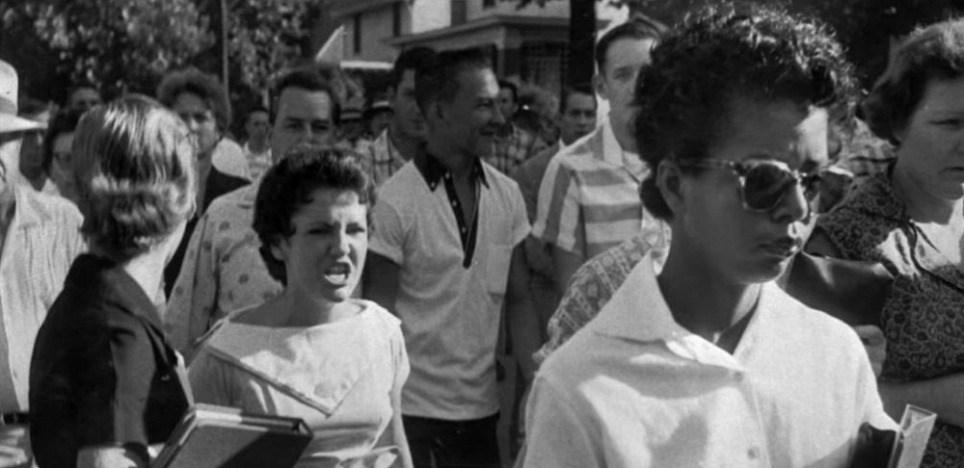Image Credit: Will Counts/Arkansas Democrat Gazette. Hazel Massery, the young woman screaming at Elizabeth Eckford in this picture, later had a change of heart, becoming a peace activist and social worker.
The end of racial segregation of schools began with the landmark Brown vs. the Board of Education ruling in 1954, that said separate educational facilities are inherently unequal. In 1955, the Supreme Court ordered that schools be desegregated "with all deliberate speed." In many places, this change came about peacefully or with minimal resistance. Integration in Arkansas — where Governor Orval Faubus opposed integration — was quite a different matter.
In 1957, nine African-American students were recruited by Daisy Bates, president of the Arkansas branch of the National Association for the Advancement of Colored People (NAACP), to attempt to enroll in Central High school in Little Rock. On September 4, the first day of school, Governor Faubus dispatched the Arkansas National Guard to block the nine from entering, in direct defiance of the Supreme Court's ruling. An angry mob of segregationists outside the school chanted “Two, four, six, eight, we ain’t gonna integrate.”
Dr. Martin Luther King, Jr., sent a telegram to President Dwight Eisenhower urging him to “take a strong forthright stand in the Little Rock situation,” lest the process of integration be set back fifty years. He appealed to Eisenhower's morals and pride, "This is a great opportunity for you and the federal government to back up the longings and aspirations of millions of peoples of good will and make law and order a reality.”
President Eisenhower declared in a televised speech that “mob rule cannot be allowed to override the decisions of the courts.” On September 25, he called in troops to protect the students — Minnijean Brown, Terrance Roberts, Elizabeth Eckford, Ernest Green, Thelma Mothershed, Melba Patillo, Gloria Ray, Jefferson Thomas, and Carlotta Walls — so that they could attend Central High.
Troops were not allowed to enter classrooms, bathrooms, or locker rooms, though, and these courageous students faced daily insults and even physical violence. In her memoir, A Mighty Long Way, Carlotta Walls LaNier wrote, “I learned early that while the soldiers were there to make sure the nine of us stayed alive, for anything short of that, I was pretty much on my own.” A month before she received her diploma, a bomb exploded in her house, yet she returned to school the next day. In 2015 she told NBC news, “If I had not gone, they would have felt like they had won.”
To Name This Day . . .
 Video
Video
Listen to Ernest Green, the first of the Little Rock Nine to graduate from Central, tell the Associated Press about his experience during the 60th anniversary of the crisis:
 Take Action
Take Action
Sadly, resegregation has been on the rise. A 2018 article by Marion Wright Edelman, president and founder of the Children's Defense Fund, speaks of "More Threats to School Diversity." She quotes a recent scholarly report that found "Going to school with a diverse student body promotes growth in leadership, critical thinking, and the ability to work cooperatively, as well as problem-solving and interpersonal skills . . . that enable people to thrive in multiethnic workplaces — nationally and globally.” Sometimes to influence policy, we need to take a step back towards the roots of decision-making.
Edelman, in her advocacy for children, shows us a valuable way to do so. She challenges us "to encourage at least 5 children to cast a vote for the issues that matter most to them. Adults are welcome to assist young children who may need assistance reading and comprehending the topics listed on the ballot." You can read the details here. Children who feel that adults around them care to make sure their voices are heard tend to grow up to be involved citizens who respect their own point of view and the perspectives of others.
